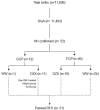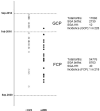Watchful waiting versus pharmacological management of small-for-gestational-age infants with hyperinsulinemic hypoglycemia
- PMID: 37435482
- PMCID: PMC10332304
- DOI: 10.3389/fendo.2023.1163591
Watchful waiting versus pharmacological management of small-for-gestational-age infants with hyperinsulinemic hypoglycemia
Abstract
Introduction: Given that reports on severe diazoxide (DZX) toxicity are increasing, we aimed to understand if the short-term clinical outcomes of small-for-gestational-age (SGA) infants with hyperinsulinemic hypoglycemia (HH) managed primarily by supportive care, termed watchful waiting (WW), are different from those treated with DZX.
Method: A real-life observational cohort study was conducted from 1 September 2014 to 30 September 2020. The WW or DZX management decision was based on clinical and biochemical criteria. We compared central line duration (CLD), postnatal length of stay (LOS), and total intervention days (TIDs) among SGA-HH infants treated with DZX versus those on a WW approach. Fasting studies determined the resolution of HH.
Result: Among 71,836 live births, 11,493 were SGA, and 51 SGA infants had HH. There were 26 and 25 SGA-HH infants in the DZX and WW groups, respectively. Clinical and biochemical parameters were similar between groups. The median day of DZX initiation was day 10 of life (range 4-32), at a median dose of 4 mg/kg/day (range 3-10). All infants underwent fasting studies. Median CLD [DZX, 15 days (6-27) vs. WW, 14 days (5-31), P = 0.582] and postnatal LOS [DZX, 23 days (11-49) vs. WW, 22 days (8-61), P = 0.915] were comparable. Median TID was >3-fold longer in the DZX than the WW group [62.5 days (9-198) vs. 16 days (6-27), P < 0.001].
Conclusion: CLD and LOS are comparable between WW and DZX groups. Since fasting studies determine the resolution of HH, physicians should be aware that clinical intervention of DZX-treated SGA-HH patients extends beyond the initial LOS.
Keywords: diazoxide; fasting study; hyperinsulinemic hypoglycemia; small-for-gestational-age; watchful waiting.
Copyright © 2023 Chandran, Jaya-Bodestyne, Rajadurai, Saffari, Chua and Yap.
Conflict of interest statement
The authors declare that the research was conducted in the absence of any commercial or financial relationships that could be construed as a potential conflict of interest.
Figures


Similar articles
-
Safety and efficacy of low-dose diazoxide in small-for-gestational-age infants with hyperinsulinaemic hypoglycaemia.Arch Dis Child Fetal Neonatal Ed. 2022 Jul;107(4):359-363. doi: 10.1136/archdischild-2021-322845. Epub 2021 Sep 20. Arch Dis Child Fetal Neonatal Ed. 2022. PMID: 34544689
-
Case report: A novel HNF1A variant linked to gestational diabetes, congenital hyperinsulinism, and diazoxide hypersensitivity.Front Endocrinol (Lausanne). 2024 Oct 3;15:1471596. doi: 10.3389/fendo.2024.1471596. eCollection 2024. Front Endocrinol (Lausanne). 2024. PMID: 39421536 Free PMC article.
-
Management of Neonatal Hyperinsulinemic Hypoglycemia: Trends Over Nine Years.R I Med J (2013). 2025 Jan 2;108(1):23-29. R I Med J (2013). 2025. PMID: 39693531
-
Efficacy and safety of diazoxide for treating hyperinsulinemic hypoglycemia: A systematic review and meta-analysis.PLoS One. 2021 Feb 11;16(2):e0246463. doi: 10.1371/journal.pone.0246463. eCollection 2021. PLoS One. 2021. PMID: 33571197 Free PMC article.
-
Diazoxide for Neonatal Hyperinsulinemic Hypoglycemia and Pulmonary Hypertension.Children (Basel). 2022 Dec 21;10(1):5. doi: 10.3390/children10010005. Children (Basel). 2022. PMID: 36670556 Free PMC article. Review.
References
-
- Hussain K, Aynsley-Green A. The effect of prematurity and intrauterine growth restriction on glucose metabolism in the newborn. Neoreviews (2004) 5:365–9. doi: 10.1542/neo.5-9-e365 - DOI
Publication types
MeSH terms
Substances
LinkOut - more resources
Full Text Sources
Medical

